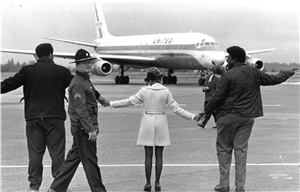On November 6, 1969, police arrest 48 protestors during a demonstration at Seattle-Tacoma International Airport (Sea-Tac) protesting discrimination in construction employment. The demonstration is part of an ongoing direct action campaign by the Central Contractors Association (CCA) to win more union construction jobs for blacks and other minorities. CCA leaders Tyree Scott (1940-2003) and Michael K. Ross (1941-2007) are among those arrested. CCA's campaign has previously succeeded in temporarily shutting down all major federally funded construction sites in the Seattle area and prompted a federal civil rights lawsuit against the largely white building trades unions. After the November demonstration at Sea-Tac, a federal judge imposes more restrictions on CCA demonstrations, but in just over six months the same judge will find the unions in violation of civil rights law and mandate a broad affirmative action program to desegregate them.
Direct Action
Tyree Scott, an electrician, and other African American contractors formed the Central Contractors Association in the spring of 1969 to seek a greater share of the many federally funded construction projects and jobs that were transforming the King County region at the time. Although local government agencies were often willing to comply, African American contractors and workers made little headway with the powerful building trades unions, which largely controlled hiring and resisted calls to open lucrative skilled construction jobs to minorities.
With the support of other civil rights activists, including Michael Ross, Scott and CCA led a dramatic direct-action campaign that "brought every major, federally funded construction site in the city of Seattle to a halt in late August and September of 1969 ... by disabling equipment, blocking workers from their jobs, and demanding that federal civil rights law be used to force unions to hire more black workers" (Griffey). Sea-Tac Airport, site of $47 million worth of federally funded construction projects that included the airport's second runway, was one of CCA's targets. In September, Scott led more than 100 demonstrators onto Sea-Tac's flight apron, delaying some flights and shutting down construction.
Court Action
One day after the demonstration on the runway, the Port of Seattle (which operates Sea-Tac), joined by the University of Washington, where CCA demonstrations had shut down construction on the massive Kane Hall/Meany Hall/"Red Square" project, asked the federal district court both to bar CCA from disrupting construction sites and to order the unions to accept minority workers. District judge William J. Lindberg agreed, issuing an injunction that prohibited CCA from disrupting construction sites and ordering that minority trainees work on the construction projects.
In addition to the federal lawsuit, Governor Dan Evans (b. 1925) proposed an affirmative action plan, but the construction unions rejected it. By October, thousands of white construction workers, organized as Voices of Irate Construction Employees (VOICE), were demonstrating in Seattle and Olympia against minority hiring.
Terminal Action
Asserting that the 20 minority trainees ordered by the court had not been accepted, Scott announced that CCA would return to Sea-Tac on November 6, 1969. King County Executive John Spellman (1926-2018) responded by declaring a state of emergency and mobilizing officers from police departments throughout the county. Complying with the injunction, the CCA demonstrators did not approach the runway or construction site. Instead, Scott and Ross led a group of about 350 people in a largely peaceful, three-and-a-half hour demonstration in the airport terminal. Leaders of VOICE did not organize a counter-protest but there were some counter-demonstrators and VOICE members observed and took photos.
The CCA demonstrators "walked, sat and milled around the reservations desks and concourse areas ... surrounded at all times by riot-clad deputy sheriffs and [police] officers" (Hannula, "50 Arrests"). Gradually the demonstration became a sit-in, with protestors sitting and singing "We Shall Overcome." The demonstrators' presence slowed passenger traffic through portions of the terminal and airport officials reported some flights were delayed, but none canceled. After several hours, police announced that the demonstrators had to leave or they would be arrested for trespassing. Scott urged supporters to stay, saying "when there were 2,000 white union workers downtown, they didn't say a word. They only enforce the law against blacks" (Hannula, "50 Arrests"). Many demonstrators did leave, but 48 were arrested, including Scott and Ross.
Affirmative Action
The following morning, at the Port's request, Judge Lindberg expanded the injunction against CCA that had previously only barred disrupting construction sites by adding stringent new prohibitions against any interference with any public facilities related to the construction hiring dispute. Even as the expanded injunction was issued, United States Attorney Stan Pitkin insisted that the Justice Department hoped to resolve the underlying discrimination complaints against the unions and construction industry within two months.
It actually took slightly over six months, but on June 16, 1970, Judge Lindberg ruled that the union hiring practices and training programs violated Title VII of the 1964 Civil Rights Act. The judge imposed a sweeping affirmative action program on the construction industry, including quotas in hiring, training, and union membership. Law professor William Gould called Lindberg's ruling "at the time of its issuance, the most comprehensive Title VII decree rendered in any court."

